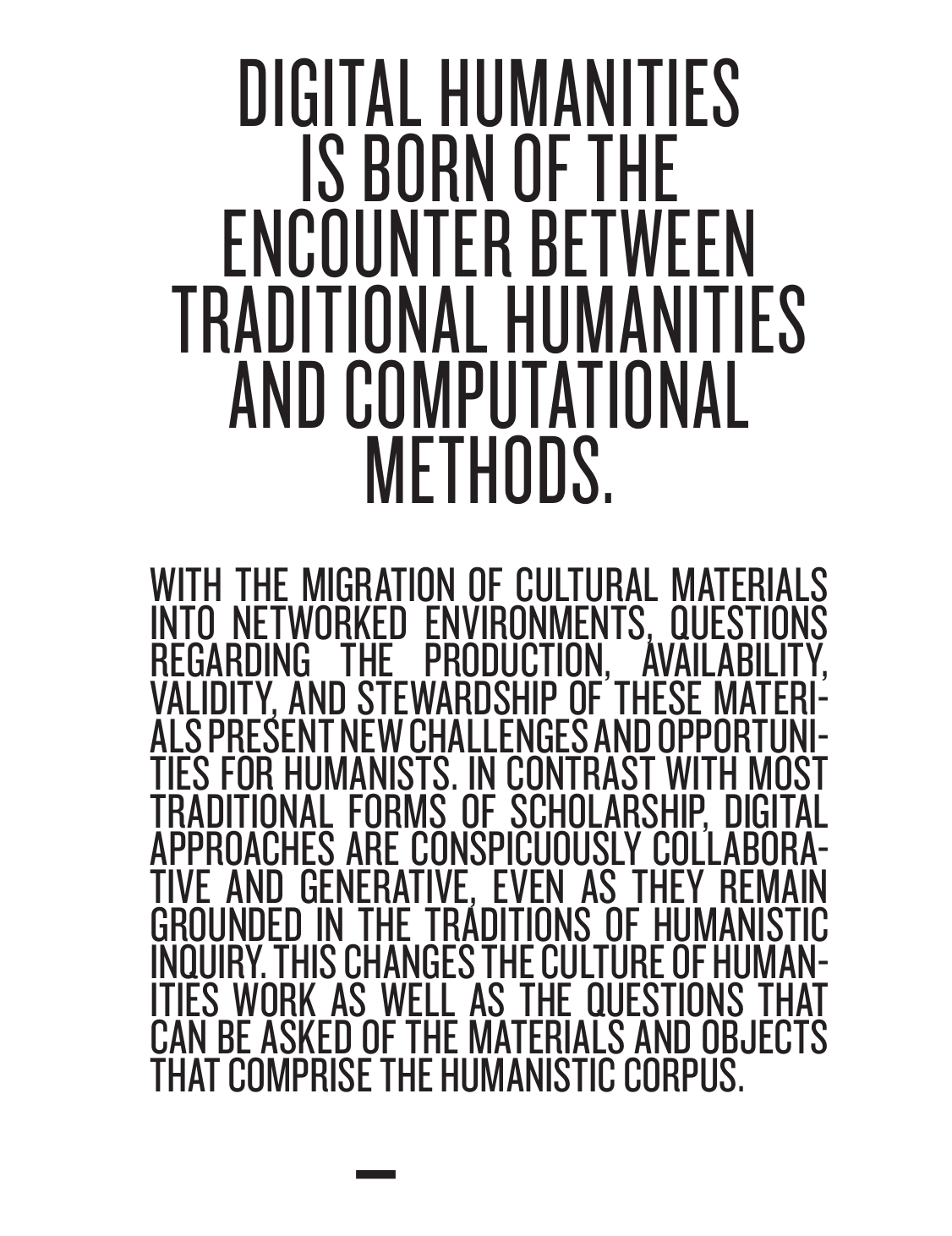Weeks 1-3: Readings and setting up the topic
Right now, my focus is mainly on readings that introduce and answer the question, “what is digital humanities?”. Since week 1 was a bit delayed due to getting final approval, etc., for the project, I’ve pushed the starting pieces together in order to ‘catch up’ to the original schedule in time to start project work.
See here the introductory page from the textbook I’m using (Burdick, et. al. (2012), Digital Humanities, MIT Press), notable for it’s description of the topic and also fun (loud) typography.

My independent study (see my syllabus for a more comprehensive introduction) is focused both on making some final project and learning about this topic. Digital humanities interested me in no small part because of how different it seemed from most of the research approaches and methods I’ve learned in my college’s predominantly qualitative sociology program.
This section of reading focused largely on developing a base understanding of digital humanities that rests on its relation to traditional humanities. Because of that, a large part of the text was spent clarifying what was meant by the term ‘traditional humaninties.’ The description explains them to be rooted in “text-based disciplines and studies” such as the classics, literature, philosophy, and more, and to summarize, says that “modern concepts of humanistic knowledge were built on authoring, narrative, and thextual models specific to the medium of print” (7). We then enter a discussion of why the humanities, as a broad set of disciplines, are important (in their words, “more necessary than ever” (ibid)). The discussion is interesting, but in short, the argument is that the humanities are responsible for both distinct models of knowledge and distinct modes of producing knowledge. As much as we value diversity of knowledge and knowledge types, we must value the humanities. Chapter two of the text goes into detail about the different types of ‘knowledge models’ that can be created.
Digital humanities (the discipline and method of study) contributes to this knowledge diversity by providing and employing new methods of knowledge creation. In other words, digital humanities work contributes to the work of traditional humanities by supplementing the methods and allowing for the investigation of different questions, as well as the investigation of existing questions in new ways. These different questions and research methods allow for distinct findings, contributing to our understandings of the world.
Moving to the relation of digital projects (my words) to the digital humanities discipline, the authors explain that the integration of the digital with the analog (textual, etc) is what allows for the digital humanities research to be carried out, as well as expressed– new types of knowledge need new mediums through which to be conveyed. A theory - implementation distinction seems to lack needed nuance, but for now, I think it’s a decent one-liner description based on this text. The integration, in relation to design, is described on p. 12: “Digital Humanities projects most closely involve communication/graphic/visual designers who are concerned with the symbolic representation of language, the graphical expression of concepts, and questions of style and identity.” To clarify the design relation, another definition is helpful: “For digital humanists, design is a creative practice harnessing cultural, social, economic, and technological constraints in order to bring systems and objects into the world. Design in dialogue with research is simply a technique, but when used to pose and frame questions about knowledge, design becomes an intellectual method” (13).
The following section goes into more specifics about the interaction between different elements and stages in the digital humanities and projects process. Regarding the former, in short: digital media are the mediums of digital projects. They require technical skills to use and design understandings to use well. Digital projects are the outcomes of digital humanities work. They come about through a process of curation, analysis, editing (refinement), and modeling. These resulting projects are the things that allow for the new forms of knowledge representation described earlier.